
‘Did world famous artist Leonardo da Vinci have ADHD? Leonardo da Vinci produced some of the world's most iconic art, but historical accounts reveal that he struggled to complete his works. Therefore, scientists think that da Vinci may have had Attention Deficit and Hyperactivity Disorder (ADHD).’
Read More..Tweet it Now
In an article in the journal BRAIN, Professor Catani lays out the evidence supporting his hypothesis, drawing on historical accounts of Leonardo's work practices and behavior. As well as explaining his chronic procrastination, ADHD could have been a factor in Leonardo's extraordinary creativity and achievements across the arts and sciences.Read More..
Professor Catani, from the Institute of Psychiatry, Psychology & Neuroscience at King's, says: 'While impossible to make a post-mortem diagnosis for someone who lived 500 years ago, I am confident that ADHD is the most convincing and scientifically plausible hypothesis to explain Leonardo's difficulty in finishing his works. Historical records show Leonardo spent excessive time planning projects but lacked perseverance. ADHD could explain aspects of Leonardo's temperament and his strange, mercurial genius.'
ADHD is a behavioral disorder characterized by continuous procrastination, the inability to complete tasks, mind-wandering, and restlessness of the body and mind. While most commonly recognized in childhood, ADHD is increasingly being diagnosed among adults including university students and people with successful careers.
Leonardo's difficulties with sticking to tasks were pervasive from childhood. Accounts from biographers and contemporaries show Leonardo was constantly on the go, often jumping from task to task. Like many of those suffering from ADHD, he slept very little and worked continuously night and day by alternating rapid cycles of short naps and time awake.
Alongside reports of erratic behavior and incomplete projects from fellow artists and patrons, including Pope Leone X, there is indirect evidence to suggest that Leonardo's brain was organized differently compared to average. He was left-handed and likely to be both dyslexic and have dominance for language in the right-hand side of his brain, all of which are common among people with ADHD.
Advertisement
Professor Catani, who specializes in treating neurodevelopmental conditions like Autism and ADHD, says: 'There is a prevailing misconception that ADHD is typical of misbehaving children with low intelligence, destined for a troubled life. On the contrary, most of the adults I see in my clinic report having been bright, intuitive children but develop symptoms of anxiety and depression later in life for having failed to achieve their potential.'
Advertisement
Source-Eurekalert









